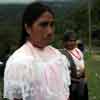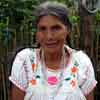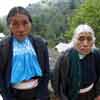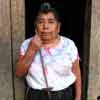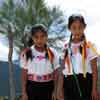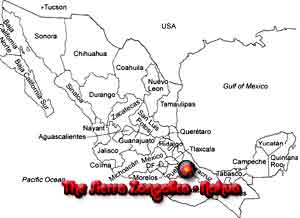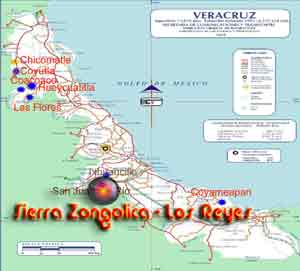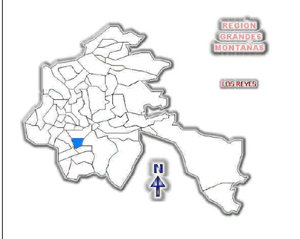 |
 |
 |
 |
|
|||||||||
| The municipality of Los Reyes is located in the Sierra Zongolica in the state of Veracruz, which is located in the central zone of the state. The municipality has approximately 33 .7 km² located in the mountains known as a Sierra Zongolica which is actually the Sierra Madre Oriental (eastern) . This part of the Sierra is known as the cold zone and has a average temperature of 17°C and 1.5 m average of rain every year. My experience in the region is that it is often covered with fog it is heavily wooded and there are many steep ravine's. The municipal capital of Los Reyes is often covered in fog. The surrounding communities have very steep hillsides on which they are located, some of the villages spread down along the ravines into the creek areas. The town of Totolinga, Cuacaballo, Atlanaca, and Ejido Atlanca are all located on steep hill sides. The municipal capital of Los Reyes is built in a canyon surrounded in the north by huge cliff, for which the town is famous, Approximately 835% of the municipality is indigenous speaking than Nahuatl language. The primary industry in los Reyes is agriculture primarily corn beans, pumpkin, and chili. This is part of the staple diet of the indigenous population of the region. Traditional costume is primarily worn by the third and fourth generation that is the grandmothers and great-grandmothers. In the towns of Totolinga and Cuacaballo there is an embroidered muslin blouse which is worn with a black full wrap skirt and a hand woven belts the reboso is worn folded wrapped around the shoulder and around the waist. In the town of Atlanta, the blouses made from store purchased lace which is worn like a large collar and to me seems like a replacement for the quechquemitl . During last visit I noticed a number of women wearing a red belt a hand woven back strap loomed textile. During this visit in October 2007 I found a wonderful example of this belt being worn in the town of los Reyes. There were some difficulty in communicating because my subject did not speak Spanish an my Nahuatl is very weak. However through a translator I was told that that red belt is worn in the entire region of Los Reyes . It is quite obvious while traveling in this municipality the level of poverty is extreme. The people were friendly and helpful in locating women that wear traditional costume. _________________________________________________________ Nahua of the Sierra Zongalica – The Sierra Zongalica is located in the Grand Mountain part of the central region of the State of Vera Cruz. The Zongalica is divided in to two zones the hot zone and the cold zone, these divisions are based on altitude more than any thing else and the costumes are distinct in the two regions. In the cold zone the costume is a black wool wrap skirt, a lace blouse, hand woven belt, a sweater and a reboso. The men wear a muslin pants and shirt with a wool poncho depending on the resource of the person they may or may not wear sandals. In the hot zone it is all white muslin blouse and skirt with pleats on the sleeves and in some cases a light machine embroidery. The mens costume is the same in both regions. In the hot area the costume is disappeasring fast. The few village shown in these galleries were far removed and only a few elderly women still wore traditional clothing. The Sierra Zongalica is inhabited by Nahua speakers who are descendent from the Nonoalco peoples. There are 14 municipalities that form this region of the State of Vera Cruz, part of the Zongalica are in the State of Puebla and are not treated here ( see Nahua of Puebla ( Tehuacan) . As mentioned earlier the peoples of this region have strong ties to the Nahua culture and due to their isolation most (90%) speak Nahuatl as their first language and even n the language of commerce. Traditional healing is alive and well in the Sierra and there is an active group of “curanderos” that live in each community. These curanderos ( healers) use herbs or a type of indigenous chiropractic healing ( hueseros) and spiritual healings. I was able to go with these healers to a traditional ceremony performed in many parts of the Zongalica called Xochical. Xochicali is a ceremony which any one can perform to ask forgiveness of mother earh for any harm caused by last years planning cycle and to ask of permission and blessing on the next agricultural cycle. This ceremony was held in a cave where the healers danced and then set up a small alter and prayed in Nahuatl and Spanish. Crafts in the region include the weaving of wool and cotton clothing, and the weaving palm items for daily use, clay is used to make all the daily plates and of course a comal where tortilla are cooked. The road building in the region will help open it up, I am really not sure how it will help the individual subsistence farmer. But at least they will be able to leave the area faster. To get into the Sierra Zongalica you can enter from the town of Orizaba located at the foot of the largest volcano in Mexico. On your map follow the freeway from Puebla toward vera Cruz and exit at Orizaba. |
|||||||||
|
|||||||||
